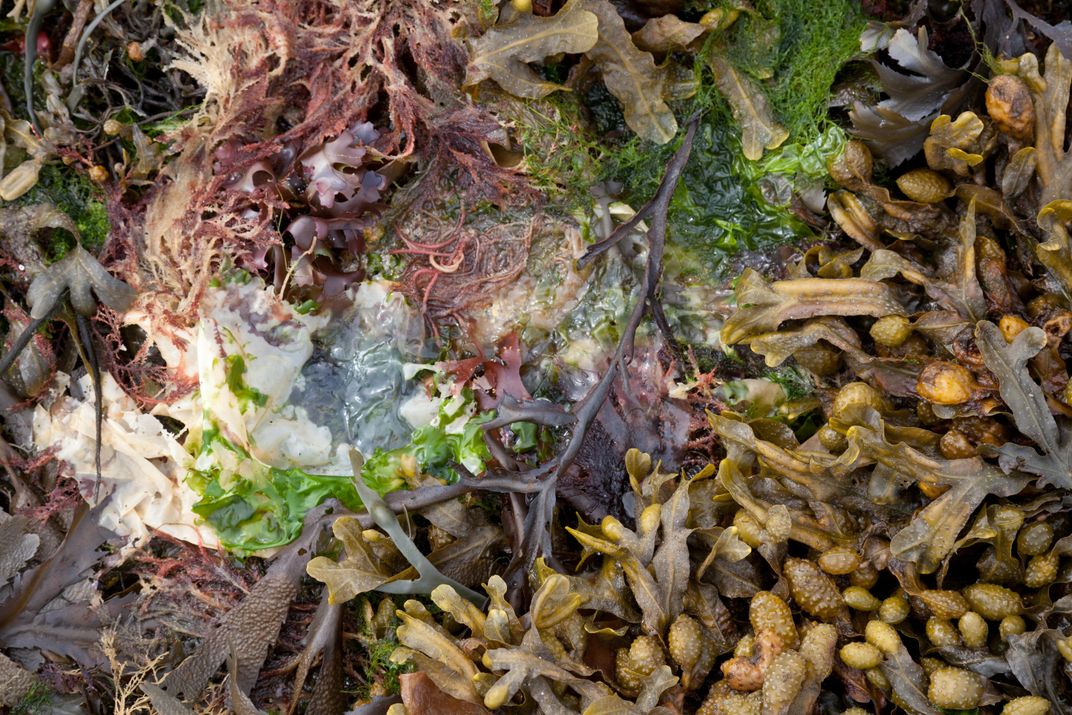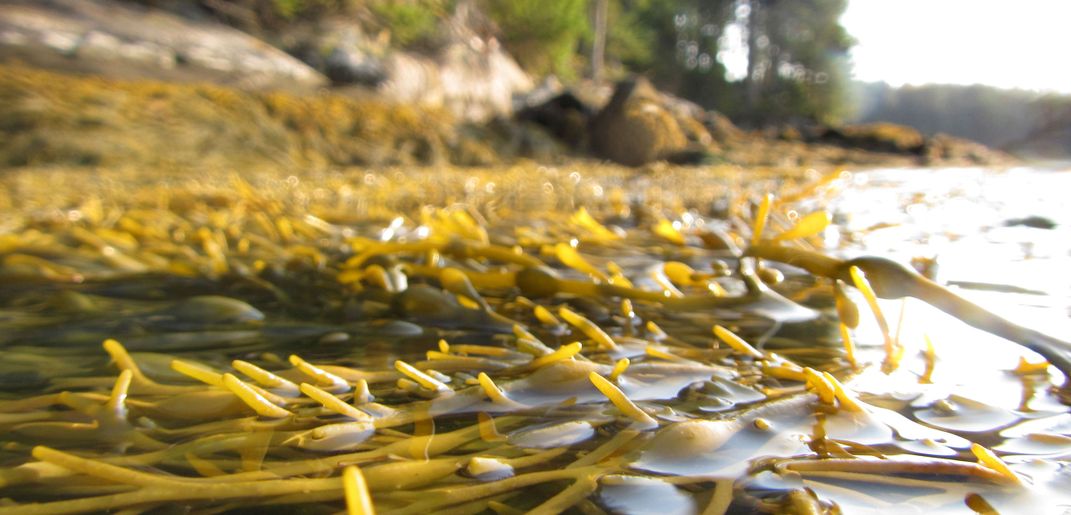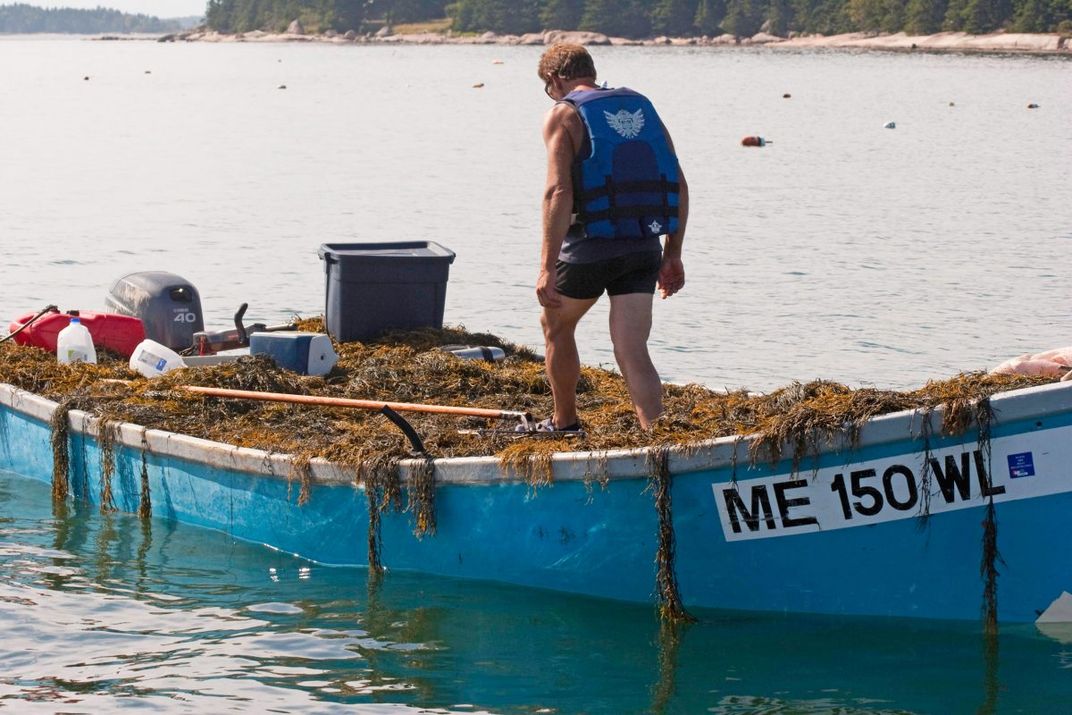How Seaweed Connects Us All
An unlikely debate about rockweed brings together Rachel Carson, marine biology and Maine’s supreme court

This article is from Hakai Magazine, an online publication about science and society in coastal ecosystems. Read more stories like this at hakaimagazine.com.
Among Rachel Carson’s many literary virtues is this: she was a keen observer of seaweed. In The Edge of the Sea, Carson’s 1955 ode to America’s eastern seaboard, she extolled the “smooth and satiny” tendrils of horsetail kelp, the “fleshy, amber-colored tubers” of sea potato, the “paper-thin layers” of dulse. Scraps of Porphyra, she wrote, resembled “little pieces of brown transparent plastic cut out of someone’s raincoat.”
No intertidal dweller captured Carson’s imagination like Ascophyllum nodosum, a rubbery, olive-colored, ubiquitous macroalgae known widely on the Atlantic coast as rockweed. The biologist was most enchanted by rockweed’s double life—how its identity changed with the tides. When the ocean withdrew from the Maine beach, she noted, the seaweed lay limp; when the tide returned, the submerged plants stood erect, “rising and swaying with a life borrowed from the sea.” The diversity of these undersea jungles, whose canopies sometimes stretch taller than two meters, enthralled Carson. “Small fishes swim, passing between the weeds as birds fly through a forest, sea snails creep along the fronds, and crabs climb from branch to branch,” she wrote.
We are accustomed to thinking of seaweed as a stage, the undulant backdrop against which play the dramas of more charismatic fish and shellfish. Today, however, rockweed stars as lead actor in one of Maine’s strangest resource conflicts. Although seaweed harvesting is hardly a new industry—New England’s farmers have nourished their fields with “sea manure” for centuries—rockweed has lately become a valuable commercial product, an ingredient in everything from fertilizers to pet foods to nutritional supplements. In 2017, Maine’s rockweeders gathered nearly nine million kilograms and raked in over $600,000, roughly four times the haul in 2001.
Inevitably, not everyone is thrilled about the boom. As rockweed’s profile has grown, the controversy over its management has escalated, ascending through Maine’s legal system all the way to the chambers of the state’s supreme court. This seaweed struggle, and the fate of A. nodosum itself, hinges on a single question, patently absurd yet bizarrely complex: is rockweed, in defiance of logic and biology, really a fish?
**********
More than two decades after Rachel Carson published The Edge of the Sea, another marine biologist developed a fascination with Maine’s littoral dwellers. In the 1980s, an eighth-generation Mainer named Robin Hadlock Seeley began her doctoral research on a small yellow snail called the smooth periwinkle. Seeley soon discovered that periwinkles’ shells had become squatter and thicker over the 20th century, an adaptive defense against invasive European green crabs. To better study the snails’ evolutionary trajectory, Seeley traveled to Maine’s Cobscook Bay, a wonderland of sheer cliffs and scrubby spruce just kilometers from the Canadian border. She found periwinkles galore, fell in love with the bay, and bought a plot of land on which she later built a home. “It was an incredible living laboratory,” she says.
In the water, rockweed provides habitat for crustaceans, fish, and mollusks; out of the water, it’s food for people and animals, fertilizer, and a soil conditioner. Video by davidobrown.com
Seeley’s bliss wouldn’t last. In 1999, a fleet of blue skiffs arrived in Cobscook Bay: rockweed boats dispatched by a Nova Scotia company called Acadian Seaplants Limited. The crews toted long-handled rakes with cutting blades, which they used to scoop up and carry off rockweed in dripping heaps. “It made no sense,” recalls Seeley, today a marine ecologist at Cornell University in Ithaca, New York. “This seaweed is the base of the food web. It’s important for fisheries, important for wildlife.” She feared for her periwinkles, a species which, Carson wrote, “knows no other home” besides rockweed. “They were hacking away at the habitat of the species I was trying to study,” Seeley sniffs, the wound still fresh.
Incensed, Seeley and other community members organized the Rockweed Coalition, a feisty group that fought to restrict cutting. The coalition won, sort of: in 2009, Maine’s legislature passed a law that divided Cobscook Bay into sectors and prevented harvesters from hauling away more than 17 percent of the rockweed from any given area each year. Yet the rest of Maine remained lightly regulated. State rules required cutters to trim above the lowest branches and no closer than 40 centimeters from the holdfast—the sturdy foot with which rockweed grips the shore—to allow the plants to regrow after each haircut. Otherwise, regulations were scant.
In part, that’s because Maine was vexed by a fundamental quandary: who owned rockweed anyway?
The source of that confusion dates to 1641, a time when present-day Maine was a remote outpost of the Massachusetts Bay Colony. The government of the young English settlement, which was reliant on maritime commerce, hoped to build more wharves for merchants to dock their ships. To spur construction, lawmakers shifted ownership of the colony’s tidal flats from the king to private landowners, eventually kickstarting the infrastructure boom that turned Boston Harbor into an economic powerhouse.
Although the transfer was a gift to the wealthy—Maine and Massachusetts are among the only states with private intertidal zones—it contained an egalitarian loophole allowing the public to use the flats for “fishing, fowling, and navigation.” Today, that rule permits a residual foraging economy in a state that’s 94 percent private property. You may not live in an oceanfront mansion, but you can gather clams or net herring anyway.

As coastal recreation evolved, Mainers’ access rights expanded. In 1952, a court permitted digging marine worms under the fishing provision; in 2011, another court decided that scuba diving qualified as navigation. Maine’s rockweed industry hinged on a similarly liberal interpretation of the ancient colonial rules. Cutting rockweed wasn’t fishing—but neither was worm digging, when you thought about it. Still, seaweed’s legal status remained murky. Did it belong to coastal landowners? Or was it a public resource, “fishable” for everyone from artisanal gatherers to international corporations?
The abstruse battle raged on. The Rockweed Coalition enrolled more than 500 properties in its “no-cut rockweed registry,” a list of parcels owned by people who disapproved of the harvest, though they had no legal power to stop it. In December 2015, Carl and Kenneth Ross, conservation-minded brothers whose family had owned land in the town of Pembroke for a century, finally decided to settle the issue, suing Acadian Seaplants for cutting their flats. An organization of other homeowners joined the suit. The seaweed, the plaintiffs insisted, was theirs—and they would go to court to prove it.
Who owns rockweed, however, is really a secondary question. First, you have to settle what it is. “Property law has always made a distinction between plants and animals,” says Gordon Smith, the Rosses’ attorney. Animals, Smith points out, are itinerant, unrooted, heedless of property borders; thus they belong to no one, or, more properly, everyone. “Whereas plants are attached to the ground,” Smith adds, “and as a result are held to be the property of the landowner.” After all, you couldn’t hop a fence into your neighbor’s backyard and saw down her maples.
But rockweed does not fit easily into existing categories. On one hand, it’s an anchored, photosynthesizing organism that, as Carson lyrically observed, forms forest-like expanses of cover—more akin to poplar than pollock. On the other, rockweed’s holdfast attaches to rock, not soil, meaning—as Acadian Seaplants’ lawyers are fond of pointing out—it draws nourishment from “public intertidal waters,” not from private ground. Yes, it spends its adult life adhered to a single spot; so does an oyster. In its habits and habitat, Acadian Seaplants wrote in one brief, “rockweed is indistinguishable from intertidal shellfish.” In fact, although it’s informally called a plant, it’s technically algae and falls under a different kingdom altogether.
Those arguments didn’t sway Judge Harold Stewart II, who in March 2017 sided with the homeowners. Rockweed harvesting, he wrote, is “no more a fishing activity … than is harvesting a tree the same as hunting or trapping wildlife.” Acadian Seaplants appealed, bumping the case up to Maine’s supreme court, which may rule this spring. It appears to be the first time a state’s highest court has concerned itself with the ecological properties of seaweed.
**********
Although rockweed’s legal status depends on an obscure snippet of colonial law, its fate has also become a case study for broader conservation questions. In November, the Property and Environment Research Center, a think tank based in distant Bozeman, Montana, whose mission is promoting “free market environmentalism,” weighed in on the saga in a Portland Press Herald op-ed. Defining rockweed as private property, the center wrote, would give landowners “the incentive to ensure that any harvesting is sustainable.”
It might seem strange that an institute headquartered in the Northern Rockies would concern itself with New England’s seaweed. But the center’s op-ed was consistent with its advocacy for catch shares, a controversial fisheries management system that seeks to preserve stocks by granting fishermen a guaranteed portion of the total catch. The rockweed dilemma, the center seems to believe, has a similar solution: the best way to save a marine resource is to privatize it.

Among the folks who take umbrage with that notion is Dave Olsen, a rockweed harvester who penned a fierce rebuttal to the center’s letter. Rockweed, he argued, “belongs in the public trust, along with the other living things in the sea”—owned by the people, accessible to all. He’d come by his anti-privatization views through hard experience. Although Olsen is a descendent of Maine fishermen, his own fishing career began in Alaska, where he gill-netted sockeye salmon. When he returned several years ago, he discovered Maine’s marine economy was closed to him. Baby eels? The fishery had been off-limits to new entrants since 2013; when it finally reopened, his odds of winning the license lottery were less than one percent. Urchins? Conservation laws effectively shut out new divers. Sure, he could work as a sternman on a lobster boat, but he figured it would take him 20 years to become eligible to captain his own vessel.
Rockweed was his only viable option. Olsen contracted with Acadian Seaplants, earning around $43.50 for every wet tonne he raked in. He quickly came to love the work—the calm dawn sea, the satisfying flop of seaweed as it slid off the tines of his rake, the way each haul engaged his back and legs. “I think of it as exercise for money,” he says. “We heap these boats up and creak back to the dock really slowly. It looks like someone is driving a mountain of seaweed over the water. It’s a great feeling, having a boatload.”
Olsen, a self-described “raging radical leftist environmentalist,” harbors not the slightest concern about the sustainability of his resource. “We’re harvesting in the same places year in and year out,” he says. “The recovery of the biomass is incredible.”
Some research backs him up: scientists at the University of Maine have suggested that because rockweed has evolved to rapidly bounce back after damage from waves, ice, and other stressors, harvesters could sustainably haul away up to 20 percent of Maine’s rockweed each year. (The Maine Department of Marine Resources estimates that annual harvest rates sit at just one percent.) Other biologists have found that cutting rockweed actually causes it to grow faster. Robin Seeley and others counter that rockweed tends to regrow as dense, low bushes rather than meters-long streamers, perhaps diminishing its value for the 150 or so critters that rely on it for food and shelter. That’s partly why the Maine Department of Inland Fisheries and Wildlife has recommended restricting harvest near dozens of sensitive islands and beaches where harlequin ducks, purple sandpipers, eiders, and other birds hunt invertebrates within rockweed fronds. “My department is not against rockweed harvest,” says Lindsay Tudor, the biologist whose shorebird studies informed the prospective closures. “We’d just like a precautionary approach.”
Olsen doesn’t draw his entire income from rockweed—like everyone else in Washington County, one of the poorest corners of Maine, he has plenty of side hustles, such as cutting the tips off balsam fir branches to make wreaths in winter. Still, he’s decided to up his investment in seaweed. He recently won a grant from the Maine Technology Institute to set up an independent harvesting operation and develop more efficient equipment, an arrangement he hopes will double his earnings.
In Ireland, another place where Acadian Seaplants has an active rockweed operation, the company’s staunchest foes are small-scale, traditional harvesters who fear being squeezed out. Likewise, Olsen worries that privatization, which would require him to secure permission to cut from intertidal landowners, could harm his nascent business: it’s easier for a large corporation to negotiate with dozens of property holders than it is for a single man. “There’s still going to be an industry,” if the supreme court rules on the side of the landowners, he says, “but it would very much restrict my ability to produce independently.”
Others put more stock in Mainers’ congeniality. “There’s a long history of people allowing their property to be used for [others] to make a living, as long as there’s a mutual respect,” says Sean Mahoney, director of Maine’s Conservation Law Foundation. Every fall, for instance, Mahoney grants hunters permission to kill deer on his land—proof, he says, that private property need not violate the spirit of the public trust. “I think Maine is a small enough state where that one-on-one kind of relationship matters.”
So far, the rockweed problem has proved only divisive, even within Maine’s famously tight-knit coastal communities. While some fishermen fear that seaweed harvesting destroys habitat, the Downeast Lobstermen’s Association has taken the opposite approach, arguing in a brief on behalf of Acadian Seaplants that rockweed is a “sustainable and reliable way for Maine lobstermen to diversify their business” in the face of environmental change. “I don’t think we want to be a state where people just sit on their decks and look at the scenery,” quips Merritt Carey, a sternman and lawyer who now serves as Acadian Seaplants’ Maine director. “Working waterfronts are a huge part of our heritage.”
Although Carey is a relative newcomer to the rockweed wars—she’s only been on the job for a year—her fresh eyes are in some ways advantageous. Where more entrenched industry reps have courted conflict, she sees the potential for reconciliation. Last fall, Carey, Mahoney, and others began planning a so-called Seaweed Roundtable, a forum for conservationists and harvesters to hash out the industry’s ground rules.
Robin Seeley, Acadian Seaplants’ most persistent opponent, is also amenable to compromise. She proposes extending the Cobscook Bay deal to the entire Maine coast—instating hard cutting caps, closing off conservation areas, and divvying the coastline into sectors to ensure that no regions get clear-cut.
“All other life,” Rachel Carson wrote, “exists within [rockweed’s] shelter.” For years, harvesters and landowners have argued over what rockweed isn’t—not quite a plant, certainly not a fish—rather than agreeing on what it is: an organism and a habitat, fundamental to an ecosystem and to an industry. Long after the supreme court has ruled on rockweed’s ownership, Maine will be left with the far greater challenge of governing its most confounding coastal species—a flowing, floating testament to the truth that all coastal creatures are interconnected, humans included.
Related Stories from Hakai Magazine: